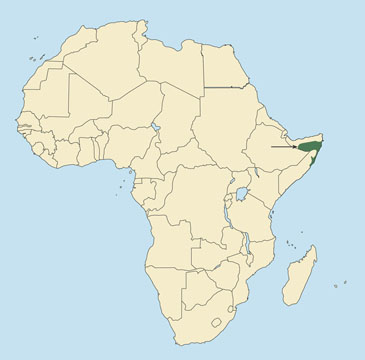 |
Gazella spekei
Gacela de Speke (Sp), Spekegazelle (G), Gazelle de Speke (F). Sometimes called plateau gazelle or upland gazelle to distinguish it from the lowland or Pelzeln gazelle. Both Speke and Pelzeln gazelles are called dero in Somali. Named after English explorer Capt. John H. Speke (1827-1864), who in 1858 was the first European to reach Lake Victoria. On a later expedition in 1862, he and Lt. James A. Grant discovered the source of the Victoria Nile at Lake Victoria.
DESCRIPTION Shoulder height 23-24 inches (58-61 cm). Weight 40-45 pounds (18-20 kg).
The Speke gazelle is a smaller gazelle with contrasting coloration and an extensible protuberance on its nose, which it can inflate when excited or alarmed. It consists of two side-by-side cavities with openings to the nasal cavities and to each other. The purpose of this feature is not known. The general color is pale fawn, with white underparts and rump, a contrasting dark brown or black lateral band, and dark pygal (rump) stripes. There is a dark brown median facial blaze, a white stripe above the eye, a brown cheek stripe below, and a black spot on the nose. Horns (both sexes) are small, heavily ringed, slightly divergent, and S-shaped backward and upward. Females are similar to males, but have thinner, straighter horns.
BEHAVIOR Lives in small family groups of 5-12. Mostly active early and late in day. Browses on foliage and herbs. Water requirements unknown, but probably slight. Eyesight, hearing and sense of smell are good. Shy and watchful.
HABITAT Bare, stony ground with scattered grass and bush, between 3,000-6,000 feet (900-1,800 m) elevation.
DISTRIBUTION The northern plateau of Somalia to within about 20 miles (32 km) of the coast (where it gives way to the Pelzeln gazelle), from about Hargeisa eastward to the Indian Ocean; and along the eastern coast of Somalia from about Ras Hafun nearly to Mogadishu. May still exist in the northern Ogaden region of Ethiopia.
TAXONOMIC NOTES No subspecies are recognized.
STATUS Reportedly still common away from villages and oil prospectors.
|




